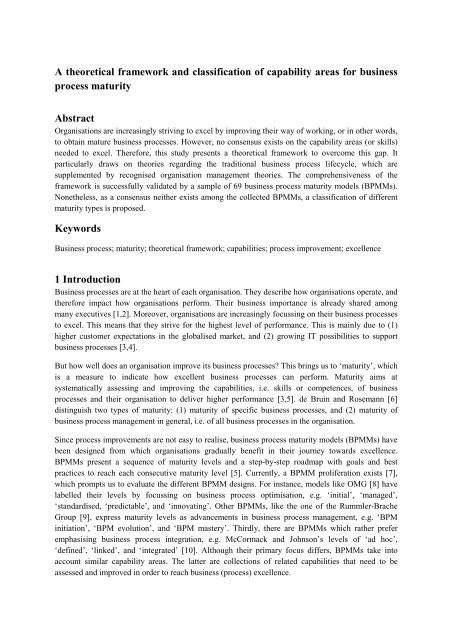A theoretical framework and classification of capability areas
A theoretical framework and classification of capability areas
A theoretical framework and classification of capability areas
Create successful ePaper yourself
Turn your PDF publications into a flip-book with our unique Google optimized e-Paper software.
A <strong>theoretical</strong> <strong>framework</strong> <strong>and</strong> <strong>classification</strong> <strong>of</strong> <strong>capability</strong> <strong>areas</strong> for business<br />
process maturity<br />
Abstract<br />
Organisations are increasingly striving to excel by improving their way <strong>of</strong> working, or in other words,<br />
to obtain mature business processes. However, no consensus exists on the <strong>capability</strong> <strong>areas</strong> (or skills)<br />
needed to excel. Therefore, this study presents a <strong>theoretical</strong> <strong>framework</strong> to overcome this gap. It<br />
particularly draws on theories regarding the traditional business process lifecycle, which are<br />
supplemented by recognised organisation management theories. The comprehensiveness <strong>of</strong> the<br />
<strong>framework</strong> is successfully validated by a sample <strong>of</strong> 69 business process maturity models (BPMMs).<br />
Nonetheless, as a consensus neither exists among the collected BPMMs, a <strong>classification</strong> <strong>of</strong> different<br />
maturity types is proposed.<br />
Keywords<br />
Business process; maturity; <strong>theoretical</strong> <strong>framework</strong>; capabilities; process improvement; excellence<br />
1 Introduction<br />
Business processes are at the heart <strong>of</strong> each organisation. They describe how organisations operate, <strong>and</strong><br />
therefore impact how organisations perform. Their business importance is already shared among<br />
many executives [1,2]. Moreover, organisations are increasingly focussing on their business processes<br />
to excel. This means that they strive for the highest level <strong>of</strong> performance. This is mainly due to (1)<br />
higher customer expectations in the globalised market, <strong>and</strong> (2) growing IT possibilities to support<br />
business processes [3,4].<br />
But how well does an organisation improve its business processes? This brings us to ‘maturity’, which<br />
is a measure to indicate how excellent business processes can perform. Maturity aims at<br />
systematically assessing <strong>and</strong> improving the capabilities, i.e. skills or competences, <strong>of</strong> business<br />
processes <strong>and</strong> their organisation to deliver higher performance [3,5]. de Bruin <strong>and</strong> Rosemann [6]<br />
distinguish two types <strong>of</strong> maturity: (1) maturity <strong>of</strong> specific business processes, <strong>and</strong> (2) maturity <strong>of</strong><br />
business process management in general, i.e. <strong>of</strong> all business processes in the organisation.<br />
Since process improvements are not easy to realise, business process maturity models (BPMMs) have<br />
been designed from which organisations gradually benefit in their journey towards excellence.<br />
BPMMs present a sequence <strong>of</strong> maturity levels <strong>and</strong> a step-by-step roadmap with goals <strong>and</strong> best<br />
practices to reach each consecutive maturity level [5]. Currently, a BPMM proliferation exists [7],<br />
which prompts us to evaluate the different BPMM designs. For instance, models like OMG [8] have<br />
labelled their levels by focussing on business process optimisation, e.g. ‘initial’, ‘managed’,<br />
‘st<strong>and</strong>ardised, ‘predictable’, <strong>and</strong> ‘innovating’. Other BPMMs, like the one <strong>of</strong> the Rummler-Brache<br />
Group [9], express maturity levels as advancements in business process management, e.g. ‘BPM<br />
initiation’, ‘BPM evolution’, <strong>and</strong> ‘BPM mastery’. Thirdly, there are BPMMs which rather prefer<br />
emphasising business process integration, e.g. McCormack <strong>and</strong> Johnson’s levels <strong>of</strong> ‘ad hoc’,<br />
‘defined’, ‘linked’, <strong>and</strong> ‘integrated’ [10]. Although their primary focus differs, BPMMs take into<br />
account similar <strong>capability</strong> <strong>areas</strong>. The latter are collections <strong>of</strong> related capabilities that need to be<br />
assessed <strong>and</strong> improved in order to reach business (process) excellence.

















